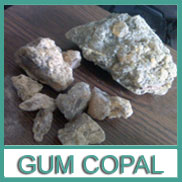Gum Copal is taken from Copal trees, which only grow in East Indonesia. Copal is a rosin obtained from exudates of the trees species Agathis coranthifolia. The forest area of Agathis-coranthifolia is about 188.500 ha. Gum Copal is easy to melt in Alcohol and have a specific smell like mint. Quality of Gum Copal also depends on the cleanliness, dust contain and Colour. High quality Gum Copal is light yellow such as PWS quality.

GUM COPAL OVERVIEW
• APPLICATION
• SPECIFICATION
The copals are a class of hard resins used principally in varnish manufacture. They are of various origins, both geographically and botanically. Their principal characteristics are their hardness, high melting point and comparative insolubility unless subjected to destructive distillation. There are three chief varieties:
(1) Fossil copal, found in the ground in localities where the trees yielding it have entirely disappeared.
(2) Semi-fossil copal, collected from the ground in the neighborhood of living copal trees.
(3) Fresh copal, found on living trees, either as the result of natural exudation or from artificial incisions. The fresh copal is of the least value and the fossil copal is the most highly prized.
East African copals, known in commerce as Ammi gum or resin, are fossil varieties coming from Zanzibar, Madagascar and along the East African Coast. American copals are collected in South America and probably originated from trees related to those which produced the East African copals, although the product is softer. Kauri or cowrie copal or Kauri gum, as it is often called, is found in New Zealand exclusively. M. Kahan has investigated Acera copal and Benin copal (Arch. d. Pharm., 1910, ccxiviii, p. 443) and gives the percentages of the various constituents found.
The Sierra Leone copal is described by Daniell as occurring “in small round tears, or irregular conical and smooth nodulated masses, seldom exceeding in size an ordinary duck egg. They are covered, to a greater or less extent, by a peculiar white efflorescence, which increases by age. Their color graduates from a pale green to a lemon or dull yellow.”
GUM COPAL APPLICATION
The natural materials have been extensively used in the field of drug delivery because they are readily available, cost-effective, eco-friendly, capable of multitude of chemical modifications, potentially degradable and compatible due to their natural origin. Past research therefore studied and acknowledged various natural gums like agar, konjac, guar gum, chitosan, xanthan gum, sodium alginate and locust bean gum for potential pharmaceutical and biomedical applications. These articulars explicate the rationale why proposed article concerns the evaluation of natural gums for sustained drug delivery.
Gum copal (GC) is a natural resinous material of plant Bursera bipinnata (family Burseraceae ). It has been used as a raw material for varnish because it produces glossy films with good weather protection propertie. It has been used as pigment binder in varnishes due to the excellent binding properties. It has been mainly used as an emulsifier and stabilizer for the production of colour, paints, printing inks, aromatic emulsions and meat preservative. Interestingly, GC was also used as medicine for several different ailments such as in the treatment of burns, headache, nosebleed, fever, stomachache, and in the preparation of dental products and as remedy for loose teeth and dysentery.
GUM COPAL SPECIFICATION
REPORT of ANALYSIS
ASH CONTENT, % : 0.12
MELTING POINT, °C : 87
COLOUR GARDNER : below 1
SAPONIFICATION NUMBER : 171.38
ACID NUMBER : 125.82
LOSS ON DRYING, % : 0.82
INSOLUBLE IMPURITIES, % : 0.005
PRODUCT SPECIFICATION
Net weight : 75 Kgs
Gross weight : 76 Kgs
Packaging : In Gunny bag
Ash Content : 3%
Melting point : 67°C
Density : 1074.7 Kgs/m3
